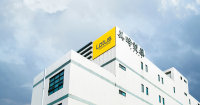
Lotus Pharmaceutical Co Ltd
TWSE:1795


| US |

|
Johnson & Johnson
NYSE:JNJ
|
Pharmaceuticals
|
| US |

|
Berkshire Hathaway Inc
NYSE:BRK.A
|
Financial Services
|
| US |

|
Bank of America Corp
NYSE:BAC
|
Banking
|
| US |

|
Mastercard Inc
NYSE:MA
|
Technology
|
| US |

|
UnitedHealth Group Inc
NYSE:UNH
|
Health Care
|
| US |

|
Exxon Mobil Corp
NYSE:XOM
|
Energy
|
| US |

|
Pfizer Inc
NYSE:PFE
|
Pharmaceuticals
|
| US |

|
Palantir Technologies Inc
NYSE:PLTR
|
Technology
|
| US |

|
Nike Inc
NYSE:NKE
|
Textiles, Apparel & Luxury Goods
|
| US |

|
Visa Inc
NYSE:V
|
Technology
|
| CN |

|
Alibaba Group Holding Ltd
NYSE:BABA
|
Retail
|
| US |

|
3M Co
NYSE:MMM
|
Industrial Conglomerates
|
| US |

|
JPMorgan Chase & Co
NYSE:JPM
|
Banking
|
| US |

|
Coca-Cola Co
NYSE:KO
|
Beverages
|
| US |

|
Walmart Inc
NYSE:WMT
|
Retail
|
| US |

|
Verizon Communications Inc
NYSE:VZ
|
Telecommunication
|
Utilize notes to systematically review your investment decisions. By reflecting on past outcomes, you can discern effective strategies and identify those that underperformed. This continuous feedback loop enables you to adapt and refine your approach, optimizing for future success.
Each note serves as a learning point, offering insights into your decision-making processes. Over time, you'll accumulate a personalized database of knowledge, enhancing your ability to make informed decisions quickly and effectively.
With a comprehensive record of your investment history at your fingertips, you can compare current opportunities against past experiences. This not only bolsters your confidence but also ensures that each decision is grounded in a well-documented rationale.
Do you really want to delete this note?
This action cannot be undone.

| 52 Week Range |
230
342
|
| Price Target |
|
We'll email you a reminder when the closing price reaches TWD.
Choose the stock you wish to monitor with a price alert.

|
Johnson & Johnson
NYSE:JNJ
|
US |

|
Berkshire Hathaway Inc
NYSE:BRK.A
|
US |

|
Bank of America Corp
NYSE:BAC
|
US |

|
Mastercard Inc
NYSE:MA
|
US |

|
UnitedHealth Group Inc
NYSE:UNH
|
US |

|
Exxon Mobil Corp
NYSE:XOM
|
US |

|
Pfizer Inc
NYSE:PFE
|
US |

|
Palantir Technologies Inc
NYSE:PLTR
|
US |

|
Nike Inc
NYSE:NKE
|
US |

|
Visa Inc
NYSE:V
|
US |

|
Alibaba Group Holding Ltd
NYSE:BABA
|
CN |

|
3M Co
NYSE:MMM
|
US |

|
JPMorgan Chase & Co
NYSE:JPM
|
US |

|
Coca-Cola Co
NYSE:KO
|
US |

|
Walmart Inc
NYSE:WMT
|
US |

|
Verizon Communications Inc
NYSE:VZ
|
US |
This alert will be permanently deleted.
 Lotus Pharmaceutical Co Ltd
Lotus Pharmaceutical Co Ltd
Lotus Pharmaceutical Co Ltd
Investor Relations
Lotus Pharmaceutical Co., Ltd., nestled at the intersection of innovation and healthcare, has carved a niche in the competitive pharmaceuticals landscape. Founded in Taiwan, Lotus has evolved into a prominent player, with a strategic focus on the development, manufacturing, and distribution of high-barrier generic drugs and specialty pharmaceuticals. Its journey began as a local pharmaceutical manufacturer but rapidly expanded its horizons through well-timed acquisitions and partnerships. These strategic moves have not only broadened its portfolio but also fortified its foothold in various international markets. The company leverages cutting-edge research and development capabilities to produce cost-effective alternatives to branded medications, which require significant expertise to replicate due to complex manufacturing processes and stringent regulatory requirements.
Lotus’s operations hinge on its ability to navigate the intricacies of pharmaceutical regulations and patent landscapes, enabling it to introduce generics as soon as original drug patents expire. This strategic agility allows the company to capture market share quickly and maximize its revenue potential. Lotus Commercializes its products primarily in Asia while also extending its reach to North America and Europe through a network of collaborations and partnerships. Its robust portfolio spans several therapeutic areas, including oncology, central nervous system disorders, and cardiovascular diseases, where the demand for affordable medications is acute. As a result, Lotus not only generates substantial revenue but also plays a pivotal role in enhancing healthcare accessibility and affordability across the globe.

Lotus Pharmaceutical Co., Ltd., nestled at the intersection of innovation and healthcare, has carved a niche in the competitive pharmaceuticals landscape. Founded in Taiwan, Lotus has evolved into a prominent player, with a strategic focus on the development, manufacturing, and distribution of high-barrier generic drugs and specialty pharmaceuticals. Its journey began as a local pharmaceutical manufacturer but rapidly expanded its horizons through well-timed acquisitions and partnerships. These strategic moves have not only broadened its portfolio but also fortified its foothold in various international markets. The company leverages cutting-edge research and development capabilities to produce cost-effective alternatives to branded medications, which require significant expertise to replicate due to complex manufacturing processes and stringent regulatory requirements.
Lotus’s operations hinge on its ability to navigate the intricacies of pharmaceutical regulations and patent landscapes, enabling it to introduce generics as soon as original drug patents expire. This strategic agility allows the company to capture market share quickly and maximize its revenue potential. Lotus Commercializes its products primarily in Asia while also extending its reach to North America and Europe through a network of collaborations and partnerships. Its robust portfolio spans several therapeutic areas, including oncology, central nervous system disorders, and cardiovascular diseases, where the demand for affordable medications is acute. As a result, Lotus not only generates substantial revenue but also plays a pivotal role in enhancing healthcare accessibility and affordability across the globe.





























 You don't have any saved screeners yet
You don't have any saved screeners yet
